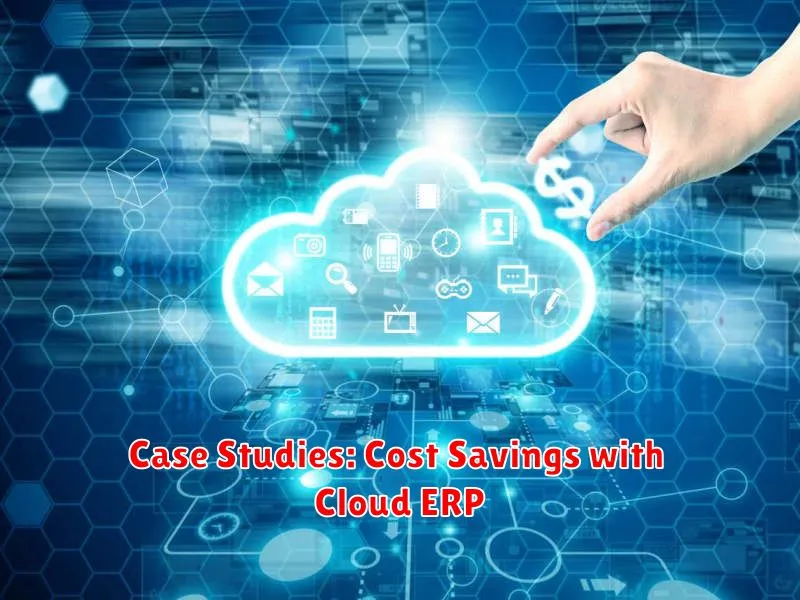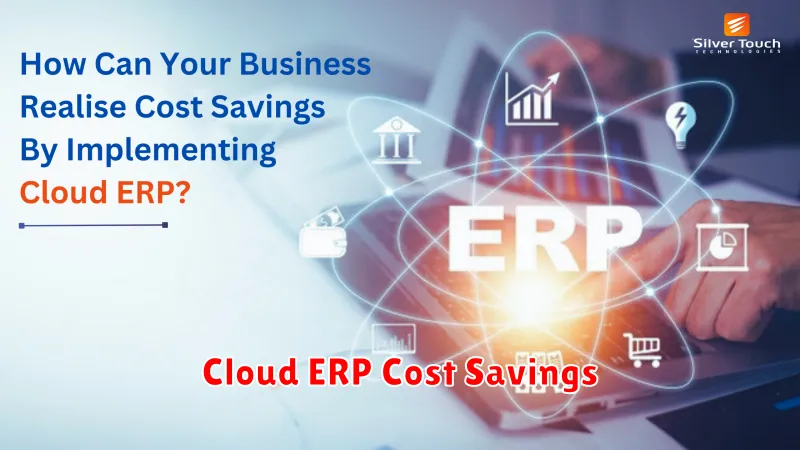Are you looking for ways to reduce costs and improve efficiency in your business? Then you need to consider a cloud-based ERP system! These systems offer a range of benefits that can help your business save money and streamline operations, including lower IT costs, increased flexibility, and improved collaboration. In this article, we’ll discuss the key ways in which cloud ERP systems can help you reduce costs and boost your bottom line.
Understanding the Cost Benefits of Cloud ERP
In today’s competitive business landscape, organizations are constantly seeking ways to optimize their operations and gain a competitive edge. One crucial aspect of this pursuit is finding cost-effective solutions for managing essential business functions. This is where cloud ERP comes into play, offering a compelling alternative to traditional on-premise systems.
Cloud ERP systems are hosted on the cloud, allowing businesses to access their applications and data from anywhere, anytime. This inherent flexibility translates into significant cost savings compared to traditional on-premise systems. Let’s delve into the key cost benefits of cloud ERP:
Reduced Infrastructure Costs
On-premise ERP systems require significant upfront investments in hardware, software licenses, and IT infrastructure. Maintaining these systems also incurs ongoing expenses, including server maintenance, power consumption, and security updates. Cloud ERP eliminates these capital expenditures and ongoing maintenance costs. By hosting the system on the cloud, businesses can leverage the provider’s infrastructure and resources, freeing themselves from the burden of hardware and maintenance.
Lower Operational Costs
Cloud ERP solutions offer substantial operational cost savings. The cloud provider manages all aspects of the system, including server management, software updates, security patching, and disaster recovery. This eliminates the need for in-house IT personnel to handle these tasks, reducing labor costs and freeing up internal resources to focus on core business activities.
Scalability and Flexibility
Cloud ERP systems are highly scalable, allowing businesses to adjust their resource allocation based on changing needs. As businesses grow or shrink, they can easily scale their cloud ERP environment up or down without the need for major infrastructure upgrades. This flexibility ensures that businesses are always paying for the resources they need, eliminating the need to overprovision or underutilize resources, ultimately resulting in cost optimization.
Reduced Implementation Costs
The implementation of traditional on-premise ERP systems can be a complex and expensive process, often requiring extensive customization and integration with existing systems. Cloud ERP solutions, on the other hand, often have pre-configured modules that can be quickly deployed and integrated with other cloud services. This streamlined implementation process significantly reduces the overall cost of deploying an ERP system.
Conclusion
The cost benefits of cloud ERP are undeniable. By leveraging the cloud, businesses can significantly reduce their infrastructure, operational, and implementation costs. Moreover, cloud ERP offers flexibility and scalability, enabling businesses to adapt to changing needs and optimize resource allocation. As organizations strive to enhance their cost-efficiency and competitiveness, adopting cloud ERP presents a compelling solution for managing their essential business functions.
Reduced IT Infrastructure Costs
In today’s rapidly evolving technological landscape, businesses are constantly seeking ways to streamline their operations and reduce costs. One area where significant savings can be achieved is IT infrastructure. By adopting a cloud-based approach, organizations can significantly reduce their infrastructure expenses and unlock a range of benefits.
Eliminate On-Premise Hardware Costs
Traditionally, businesses have relied on physical servers, storage devices, and other on-premise hardware to support their IT needs. This infrastructure requires significant capital investment, ongoing maintenance, and space for housing the equipment. With cloud computing, organizations can eliminate these costs entirely. Cloud providers handle all the hardware and maintenance, allowing businesses to focus on their core competencies.
Reduce Power Consumption and Cooling Costs
On-premise data centers consume vast amounts of electricity to power servers and cooling systems. By migrating to the cloud, organizations can significantly reduce their power consumption and associated cooling costs. Cloud providers leverage energy-efficient data centers and optimize resource utilization, resulting in substantial savings.
Lower Staffing and Maintenance Costs
Managing on-premise IT infrastructure requires a dedicated team of IT professionals responsible for installation, configuration, maintenance, and troubleshooting. Cloud computing eliminates the need for such extensive in-house expertise. Cloud providers offer 24/7 support, monitoring, and security, reducing staffing and maintenance costs.
Flexible Scaling and Pay-as-You-Go Pricing
With cloud infrastructure, businesses can easily scale their resources up or down as needed, paying only for what they use. This flexibility allows organizations to avoid overprovisioning and reduce costs associated with unused capacity. Cloud providers offer various pricing models, including pay-as-you-go, subscription-based, and reserved instances, providing options to suit different budget requirements.
Increased Agility and Business Growth
Reduced IT infrastructure costs free up valuable resources that can be redirected towards innovation and business growth. By leveraging the agility and scalability of the cloud, organizations can rapidly respond to changing market demands, launch new products and services, and achieve faster time-to-market.
Conclusion
Cloud computing offers a compelling solution for businesses looking to reduce their IT infrastructure costs. By eliminating on-premise hardware, reducing power consumption, lowering staffing requirements, and embracing flexible scaling, organizations can achieve significant cost savings while unlocking increased agility and growth opportunities.
` * `
` * `` * `
` I can also include other HTML tags to enhance the content, such as: * `` for bold text * `` for italic text * `
` tags. Once you provide me with the text, I will format it according to your specifications.
Scalability and Flexibility
Scalability and flexibility are essential concepts in software development. Scalability refers to the ability of a system to handle increasing workloads and user traffic without compromising performance. A scalable system can grow with its user base without requiring significant changes to its infrastructure. Flexibility, on the other hand, refers to the ability of a system to adapt to changing requirements and business needs. A flexible system can be easily modified and extended without significant rework.
In today’s rapidly changing technological landscape, scalability and flexibility are more important than ever. Businesses need systems that can handle the demands of a growing customer base and adapt to new market trends. Scalable and flexible systems provide businesses with the agility they need to stay ahead of the competition.
Benefits of Scalability and Flexibility
There are numerous benefits to building scalable and flexible systems, including:
- Improved Performance: Scalable systems can handle large amounts of data and traffic without slowing down. This ensures a positive user experience, even during peak periods.
- Increased Efficiency: Flexible systems can be easily adapted to changing business needs, allowing businesses to streamline their operations and improve efficiency.
- Reduced Costs: By building scalable and flexible systems, businesses can avoid the need for expensive infrastructure upgrades in the future. This can save businesses significant amounts of money over the long term.
- Faster Time-to-Market: Flexible systems can be quickly modified and extended, allowing businesses to launch new products and services faster.
- Enhanced Security: Scalable and flexible systems can be easily updated to address new security threats, ensuring the safety of data and applications.
Achieving Scalability and Flexibility
There are several strategies that developers can use to build scalable and flexible systems, including:
- Cloud Computing: Cloud computing provides a scalable and flexible infrastructure that can be easily scaled up or down as needed.
- Microservices Architecture: Microservices architecture breaks down large applications into smaller, independent services that can be easily scaled and deployed independently.
- Containerization: Containerization allows developers to package applications and their dependencies into portable units that can be easily deployed on any platform.
- API-First Development: API-first development allows businesses to build systems that are easy to integrate with other applications and services.
- DevOps Practices: DevOps practices, such as continuous integration and continuous delivery, help businesses to build and deploy software faster and more efficiently.
By incorporating these strategies into their development process, businesses can build scalable and flexible systems that can support their growth and adapt to changing market conditions.
Case Studies: Cost Savings with Cloud ERP

Cloud ERP has become increasingly popular in recent years, and for good reason. Cloud-based ERP systems offer a number of advantages over traditional on-premises systems, including lower costs, improved scalability, and increased flexibility. In this article, we will explore some real-world case studies of how businesses have achieved significant cost savings by switching to Cloud ERP.
Case Study 1: A Manufacturing Company
A large manufacturing company was struggling with outdated, on-premises ERP software. The software was expensive to maintain, difficult to use, and lacked the functionality the company needed. After switching to a Cloud ERP system, the company saw a dramatic reduction in its IT costs. The company also benefited from increased productivity and improved data visibility.
Case Study 2: A Retail Company
A retail company was looking to expand its operations into new markets. The company needed a flexible and scalable ERP system that could support its growth. After implementing a Cloud ERP solution, the company was able to expand its business rapidly without having to invest in expensive new hardware or software. The company also saw significant cost savings by eliminating the need for on-site IT staff.
Case Study 3: A Healthcare Provider
A healthcare provider was looking for a way to improve its patient care and reduce costs. The provider chose to implement a Cloud ERP system that offered a number of benefits, including improved patient records management, better communication between providers, and reduced administrative costs. The provider was also able to reduce its carbon footprint by eliminating the need for on-premises servers.
Conclusion
These are just a few examples of how businesses have achieved significant cost savings by switching to Cloud ERP. If you are considering a move to the cloud, it is important to carefully evaluate your needs and choose the right solution for your business. By doing so, you can reap the many benefits of Cloud ERP, including reduced costs, improved efficiency, and increased agility.
